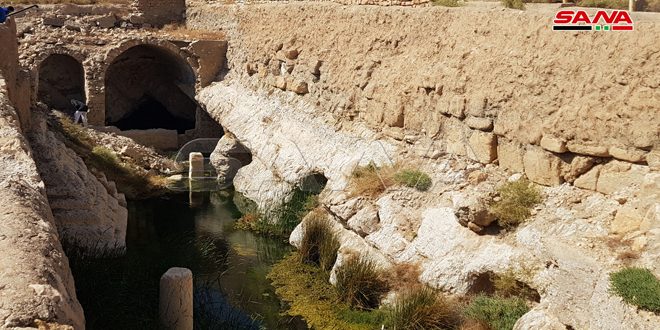Palmyra, (ST)- With the participation of the local community, Homs Governorate, Palmyra City Council and the Antiquities Directorate , a voluntary project to clean and rehabilitate the stream of the historic Afqa Spring and remove the dust and stones left by the terrorists from the entrance and inside the tunnel was started.
The project aims to restore the flow of spring water that flowed last April for the first time after a drought that lasted for about 25 years and to revive this archaeological tourist facility, which was one of the reasons for the existence of Palmyra and the gathering of mankind in this region for more than six thousand years.
Member of the Executive Office for the Water and Irrigation Sector in Homs Governorate, Kamal Al -Hallaq, stated in a statement to SANA that this project which is being carried out with the initiative of the people of the region who work manually to avoid damaging this archaeological site .Their work involves isolating and cleaning the stairs and the course of the cave. This is important because it contributes to the revival of the spring’s water and the continuation of its flow towards the thirsty orchards of Palmyra oasis .He indicated that a technical schedule has been set for this important project until the Afqa spring returns as it was before.
Paul Kassis, head of the Environmental Development Foundation participating in the project, explained in a similar statement that preserving the archaeological spring of Afqa which is characterized by the constant temperature of its water in summer and winter, estimated at about 33 C, contributes to the return of life to the oasis of the olive and palm trees and preserves the environment in the region, stressing the importance of community participation in saving the spring from drought again and helping to restore its flow naturally.
 For his part, secretary of the National Museum of Palmyra, archaeologist Khalil al-Hariri, explained that the spring of Afqa was the reason for the prosperity of the city of Palmyra through the ages and the continuity of life in this region for more than six thousand years , as its waters flow into a cave about 400 meters long inside the hollow of a al-Muntar mountain, pointing out that the waters of this spring, which preserved its archaeological cave, were sacred to the ancient Palmyrians who used to offer sacrifices and offerings to the spring god “Rahboul”, who gave permanent blessing of this water and the hope of its continuity.
For his part, secretary of the National Museum of Palmyra, archaeologist Khalil al-Hariri, explained that the spring of Afqa was the reason for the prosperity of the city of Palmyra through the ages and the continuity of life in this region for more than six thousand years , as its waters flow into a cave about 400 meters long inside the hollow of a al-Muntar mountain, pointing out that the waters of this spring, which preserved its archaeological cave, were sacred to the ancient Palmyrians who used to offer sacrifices and offerings to the spring god “Rahboul”, who gave permanent blessing of this water and the hope of its continuity.
Nidal Ali, one of the volunteers to clean the stream of the spring, indicated that the people of the city were happy when they saw the spring water flow again, especially after removing part of the piles of dirt that hinder the flow of water inside the stream, explaining that this work helps the people and farmers return to their farms that the terrorists sought to sabotage. He stressed that the water of this spring is considered a tourist destination for visitors, as it is a means of healing from many diseases, especially skin, intestinal and joint diseases.
Amal Farhat

